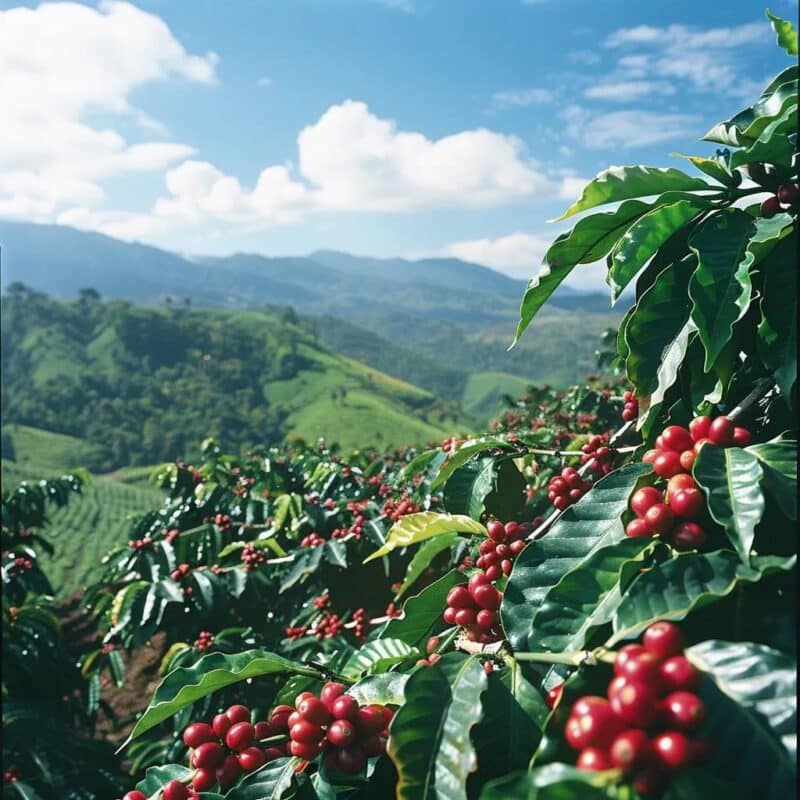Discover the World of Single Origin Coffee: Meaning, Benefits, and Brewing Tips

Discover the World of Single Origin Coffee: Meaning, Benefits, and Brewing Tips
Single origin coffee is a journey in a cup, sourced from one specific location, offering a taste of its unique environment. This guide will take you through the essence of single origin coffee, its standout benefits like diverse flavours, traceability, and sustainability, and how terroir and processing methods play a role. You’ll also learn the best brewing techniques, how it compares to blends, and where to find top-notch single origin brands. By the end, you’ll see why this coffee captivates enthusiasts and how to enjoy it to its fullest.
Understanding Single Origin Coffee: Definition and Key Concepts
Single origin coffee is all about beans from a single place—be it a farm, estate, or micro-lot—capturing the essence of that location’s environment and farming practices. This precise sourcing ensures transparency from cultivation to roasting, connecting you directly with the producers and their unique growing methods. Grasping these concepts is key to appreciating how origin influences taste and traceability.
Single Origin vs. Single Farm vs. Micro-Lot: What's the Difference?
Single origin coffee comes from one geographic area, while single farm coffee is from a specific farm. Micro-lot coffee is even more specific, from a small, carefully managed plot within a farm, often highlighting exceptional quality. These distinctions—from region to farm to lot—enhance both flavour uniqueness and traceability, guiding you to more precise coffee experiences.
The Role of Traceability in Single Origin Coffee
Traceability means every step—from cherry selection to roasting—can be traced back to a specific producer or cooperative. This transparency builds trust, supports direct trade, and lets you verify sustainability or ethical sourcing. It also allows roasters to share farmer stories and environmental efforts, deepening your connection to the coffee.
Single Origin vs. Blends: What Sets Them Apart?
Single origin coffee captures the unique traits of one locale, while blends mix beans from various origins for a consistent flavour. This means single origin coffees often showcase distinct seasonal and regional nuances, like floral Ethiopian notes or chocolatey Central American undertones, while blends focus on balanced taste and steady availability.
The Evolution of Single Origin Coffee in the Specialty Industry
Over the past two decades, the specialty coffee movement has embraced single origin coffee to meet the demand for authenticity, quality, and fairness. Early adopters highlighted origin stories and farmer partnerships. Today, single origin offerings drive innovation in processing, elevate appreciation for coffee genetics and terroir, and support sustainability by empowering smallholder producers with premium pricing.
The Benefits of Single Origin Coffee: Flavour, Traceability, and Sustainability
Single origin coffee offers a trio of benefits—distinctive flavours, verifiable traceability, and meaningful sustainability—making each cup a celebration of place and practice. These advantages extend from sensory enjoyment to ethical and environmental impact.
Unique and Diverse Flavour Profiles of Single Origin Coffee
Single origin coffee captures the interplay of regional altitude, soil, and climate, presenting an array of flavour notes—from bright citrus and floral aromas to rich chocolate and nutty undertones. Each batch reflects specific harvest conditions, providing tasting clarity that allows you to map origin to sensory experience and appreciate the complexity introduced by factors like varietal and processing method.
The Importance of Traceability for Coffee Drinkers
Traceability empowers you to learn exactly where and how your coffee was grown, processed, and roasted, fostering transparency and ethical accountability. Knowing a coffee’s origin supports informed choices—like selecting direct-trade or Fair Trade certified beans—and reinforces trust in quality and social responsibility. This clarity also encourages industry best practices by rewarding farmers who adhere to rigorous standards.
Supporting Sustainable and Ethical Farming Practices
Single origin sourcing often involves direct trade relationships that bypass intermediaries, channelling higher premiums to farmers. These partnerships incentivise eco-friendly practices—like shade-grown cultivation, water-efficient processing, and organic soil management—while bolstering community development through fair wages and reinvestment. As a result, single origin coffee becomes a vehicle for both environmental stewardship and social uplift.
Health Benefits of Single Origin Coffee
Single origin coffee can offer health advantages similar to other high-quality Arabica beans, including antioxidant content that may protect against cellular damage, anti-inflammatory compounds, and natural polyphenols linked to cardiovascular health. The focus on careful harvesting and processing often yields cleaner flavour and fewer defects, potentially reducing undesirable byproducts and enhancing overall cup clarity.
Terroir's Influence on Single Origin Coffee Flavour Profiles

Terroir encompasses the environmental conditions that shape a coffee’s taste—specifically altitude, soil, and climate—and directly influences bean density, acidity, and aromatic compounds. Recognising terroir factors helps decode why coffees from different regions manifest distinct flavour signatures.
The Impact of Terroir on Coffee Flavour
The unique characteristics of coffee beans are significantly influenced by terroir, which encompasses environmental factors like altitude, soil composition, and climate. These elements affect the bean’s density, acidity, and aromatic compounds, leading to distinct flavour profiles in different growing regions.
This research supports the article’s discussion on how terroir affects the flavour of single-origin coffee.
Terroir Factors: Altitude, Soil, and Climate
High altitude farming slows cherry maturation, concentrating sugars and acids to yield brighter acidity and complex flavours, while lower elevations produce fuller body coffees. Soil mineral content—such as volcanic ash or clay—imparts subtle earthy or mineral notes. Climate elements like rainfall patterns and diurnal temperature swings regulate bean development, affecting sweetness, acidity balance, and aroma profiles.
Unique Terroir Characteristics of Coffee Growing Regions
Each region’s combination of terroir elements generates signature flavour families: East African coffees often exhibit floral and berry-like notes, Central American beans lean toward cocoa and citrus brightness, South American origins deliver nutty and caramel tones, and Asian coffees present earthy, spicy, or herbal qualities. These regional signatures guide roasters and consumers in flavour exploration.
The Role of Coffee Varietals in Flavour Profiles
Coffee varietals—genetic subtypes of Arabica like Bourbon, Typica, Geisha, and Caturra—react differently to terroir, expressing unique attributes such as jasmine-like aroma in Geisha or chocolatey sweetness in Bourbon. Varietal choice combines with local terroir to create layered complexity, making discerning varietal profiles critical for appreciating single origin nuances.
Processing Methods and Their Impact on Single Origin Coffee Flavour
Processing methods transform harvested cherries into green beans, with each technique—washed, natural, or honey—shaping acidity, body, and aroma. Understanding these processes illuminates the mechanisms behind specific cup characteristics.
The Role of Processing Methods in Coffee Taste
Processing methods, such as washed, natural, and honey, play a crucial role in shaping the flavour of single-origin coffee. Each method influences the coffee’s acidity, body, and aroma, resulting in distinct cup characteristics. Washed processing typically yields cleaner acidity, while natural processing enhances fruit sweetness and body.
This citation provides further insight into how processing methods affect the taste and aroma of single-origin coffee, as discussed in the article.
Main Processing Methods: Washed, Natural, and Honey
Washed processing involves pulping cherries and fermenting to remove mucilage, resulting in cleaner acidity and clarity. Natural (dry) processing dries whole cherries on raised beds, accentuating fruit sweetness and body. Honey processing removes skin but retains varying levels of mucilage during drying, balancing the brightness of washed coffees with the sweetness of naturals.
Influence of Processing Methods on Taste and Aroma
Introductory Comparison of Processing Methods:
| Processing Method | Attribute | Cup Characteristic |
|---|---|---|
| Washed | Clean acidity | Bright, tea-like, crisp aroma |
| Natural | Fruity sweetness | Full body, berry or tropical fruit notes |
| Honey | Balanced sweetness | Moderate body, honeyed texture and aroma |
Clean acidity from washed coffees accentuates origin-specific floral and citrus notes, while natural processing amplifies sweetness and body through extended fruit contact. Honey process coffees deliver both fruit-driven sweetness and pronounced acidity in a harmonious cup.
Common Processing Methods in Popular Single Origin Regions
In Ethiopia, natural processing dominates, yielding intensely fruity and floral cups. Central America often favours washed processing for its clarity and consistency. Costa Rica is renowned for honey processing, blending sweetness with bright acidity. Understanding regional processing trends helps match flavour expectations to origin selections and guides brewing strategies.
Brewing Single Origin Coffee for Optimal Taste: Methods and Tips

To highlight single origin subtleties, brewing parameters—method, grind size, and water temperature—must align with the coffee’s characteristics. Precision brewing unlocks the fullest expression of terroir and processing.
Best Brewing Methods for Single Origin Coffee Flavours
Pour-over techniques (V60, Chemex) offer control over flow rate and extraction, accentuating clarity and delicate notes. French press emphasises body and sweetness, ideal for naturally processed beans. Espresso extraction concentrates flavours and highlights sugar complexity in honey-processed coffees. Selecting the right method depends on desired balance between acidity, body, and aroma.
Impact of Grind Size and Water Temperature on Extraction
Finer grinds increase extraction rate, enhancing acidity and clarity in pour-over brews, while coarser grounds in French press yield fuller body and lower bitterness. Water temperature between 90–96 °C optimises solubility of acids and sugars; lower temperatures preserve subtle aromatics in lighter roasts. Adjusting these variables refines sweetness, acidity, and mouthfeel.
Expert Tips for Brewing Single Origin Coffee at Home
- Use fresh, filtered water to prevent off-flavours and control mineral content.
- Pre-infuse grounds with a short bloom (30–45 seconds) to release CO₂ and improve extraction uniformity.
- Weigh beans and water to maintain a consistent brew ratio (e.g., 1:16 coffee to water).
- Stir gently or swirl mid-brew to ensure even saturation.
Applying these practices enhances reproducibility and reveals nuanced flavour dimensions in each cup, guiding you from foundational technique to advanced brewing mastery.
Single Origin Coffee vs. Blended Coffee: Key Differences
Single origin and blended coffees serve distinct purposes: the former emphasises unique regional expression while the latter prioritises consistent taste and availability. Recognising these differences clarifies consumer choices.
Flavour Consistency and Complexity: Single Origin vs. Blends
Single origin coffee delivers seasonal complexity and variable flavour profiles that reflect harvest conditions, offering vibrant acidity or unique fruit notes. Blends combine beans from multiple origins to smooth out seasonal fluctuations, providing a reliable, uniform taste but often sacrificing the distinctive traits that single origin coffees reveal.
Why Single Origin Coffee is Often Pricier Than Blends
Single origin coffee commands higher prices due to small-batch harvesting, specialised processing, and the premium paid for transparency and traceability. Direct trade relationships and limited crop sizes contribute to cost. In contrast, blends leverage larger volumes and bulk purchasing, reducing per-unit expenses but limiting origin specificity.
When to Choose Single Origin Coffee Over Blends
Consumers seeking adventurous tasting experiences, deep provenance knowledge, or farm-to-cup transparency should opt for single origin coffee. Those prioritising a familiar, steady flavour and cost-effectiveness may prefer blends. Occasions calling for exploratory cupping sessions or limited-release offerings align well with the single origin approach.
Finding the Best Single Origin Coffee Brands and How to Buy Them
Identifying quality single origin coffee involves evaluating brand transparency, sourcing practices, and roasting expertise. With these criteria, you can discover standout roasters and make informed purchasing decisions.
Criteria for Quality Single Origin Coffee Brands
Quality single origin brands demonstrate:
- Direct trade or transparent supply chains that specify farm and region.
- Freshness guarantees with roast dates clearly displayed.
- Detailed origin information including altitude, varietal, and processing.
- Sustainable certifications (e.g., organic, Rainforest Alliance) or ethical commitments.
These attributes signal authenticity and allow consumers to trace each coffee’s journey.
Reputable Brands and Roasters Specialising in Single Origin Coffee
Leading roasters focus on origin transparency and small-batch offerings, often partnering with cooperatives or individual farmers in Ethiopia’s Yirgacheffe, Colombia’s Huila, Guatemala’s Antigua, and Costa Rica’s Tarrazú. Look for specialty coffee purveyors that publish origin reports, tasting notes, and direct farmer profiles to ensure premium single origin experiences.
Buying Single Origin Coffee: Online or Locally?
Purchasing online often provides broader access to rare micro-lots and seasonal releases, alongside detailed origin information and user reviews. Local specialty coffee shops or roasters offer in-person expert guidance, immediate freshness, and support for nearby producers. Combining both channels ensures diverse selection and immediate enjoyment.
Single origin coffee celebrates the intricate connection between place, process, and palate by delivering traceable, terroir-driven cups that support sustainable farming and enrich tasting experiences. Understanding its definition, benefits, terroir influence, and processing impact empowers you to brew exceptional coffees and make conscious purchasing decisions. Whether exploring floral East African naturals or bright Central American washed beans, single origin coffee invites you to savour authenticity in every brew.

